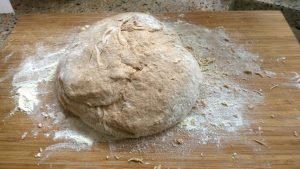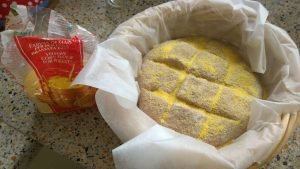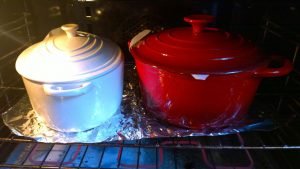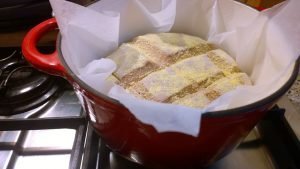Artisan sourdough bread recipe
This time I would love to share with you my favorite artisan sourdough bread recipe.
Do you remember the time when you were a small child? When I woke up on the weekend, the air of freshly baked bread, or pastries, or pancakes floated at home. The whole house was filled with the warm aroma floating in the air from the kitchen. It tickled your nose and tempted you to get up or follow this wonderful scent with your eyes still closed.
Do you remember these times? It doesn’t matter whether your mother loved cooking or not, the fond memories of your childhood always appeal to you, right? And these are the memories that passed on to me the love of cooking. It is not for nothing that people say: Love goes through your stomach. Now that I am delving into yoga and other life philosophies, I understand why when one is going through an emotionally difficult period that also feels in his stomach. The reverse is also true. Do you remember the butterflies in your stomach when you met your first love? :-)

In my previous blog article about sourdough, I promised to share my artisan sourdough bread recipe with you. I would like to add that it has been a growth process for me. Baking bread with yeast is much easier and faster. So, if you don’t want to be too difficult, go for a recipe for baking bread with yeast or choose baking bread with baking powder or baking powder in a bread maker. Only if you love a tasty, healthy, and slightly different artisan sourdough bread recipe and have the time and guts to master the art of an artisan sourdough bread recipe and bread-making read on.
In this sourdough recipe, assume that you already have your sourdough starter ready. In one of my upcoming blog articles, I guide you into the mastery of preparing sourdough starter. This artisan sourdough bread recipe is very easy and you need a handful of ingredients. This mainly concerns the correct sequence, building up a feeling for the process, and having patience. After all, you didn’t come to this Slow living blog for nothing, right?
So, whip out your sourdough starter, and let’s go with my best of all sourdough recipes!

How to prepare your sourdough starter?
I keep my sourdough starter in two glass jars with holes on the lids in the fridge. The moment I want to bake sourdough bread I take the jars with the sourdough starter out of the fridge and I “wake it up”. Yes, yes you read that right, you first have to wake up your sourdough starter from its sleep in the fridge. And you need to feed your sourdough bread starter too.
How do you do that? This is very easy.
Step 1 How to feed your sourdough starter?
You take two new clean glass jars with holes on the lids and put 1 tbsp. of your starter in each of these two glass jars.
Then pour 50 ml. clean water and slowly stirring add a few tablespoons of whole wheat flour. Three or four tablespoons of flour are usually enough.
You are going to stir all that very well and put your sourdough starter back in the fridge. Save this fresh sourdough bread starter for the next time you want to bake sourdough bread.
Step 2 This is how you feed and wake up the sourdough starter:
Now, you will use the leftover sourdough bread starter. Only first you need to feed and wake up this sourdough bread starter.
Feeding is as described in step 1. Here I make the consistency of the starter slightly thinner than when feeding it in step 1 by just adding a little more water.
Then I put the jars with my sourdough bread starter at room temperature in a draft-free place for a few hours. The time it takes for the sourdough starter to wake up and become active varies. In the summer it is faster than in the winter. In the summer I do that early in the afternoon and it is ready until the evening.
When your sourdough bread starter is ready, see the small air bubbles that happily appear on the surface of your sourdough bread starter. The size of the starter for your artisan sourdough bread should also grow and be about twice as much.
And now you are done. Finally. But I already told you that, patience is a virtue.

To prepare your very own artisan sourdough bread using my best artisan sourdough bread recipe you will need these ingredients (for 2 loaves):
200 gr. Sourdough starter
2 tbsp. Honey
2 tsp. Salt (I use sea salt)
600 ml. Water (at room temperature)
200 gr. Wheat flour (Patent flour is also allowed)
800 gr. Whole wheat flour

You will need a few kitchen utensils too. If you plan to master the baking and use an artisan sourdough bread recipe you could purchase good quality special utensils. But, for the very beginning, you could adjust and use what you have at hand. I am baking now regularly, but I still have a few things I would like to buy, like a banneton.
So, let’s go straight to the cooking stuff you will need.
– a basket where you will leave the dough to rise. It could be a simple round reed basket which you could cover with some parchment paper.
– a mixing bowl
– a big cutting board or a surface you could use to knead the dough
This is how you proceed:
- I have a bread maker and use it for kneading the dough. If you don’t have a bread maker, no problem, all you need is your strong arm muscles.
- Put the water in the mixing bowl (or bread maker), add the salt and honey.
- Then sieve the flour. Instead of wholemeal wheat flour, I regularly use wholemeal spelt flour. The spelt bread made following my artisan sourdough bread recipe is delicious too.
- Finally, add the sourdough starter to the rest.
- And now the time has come to strengthen your arm muscles. Either you are lazy (or smart, it depends on how you look at it) and just set on the “kneading” program on your bread maker. This program takes 15 minutes with my bread maker. I run the program 3 times in a row until the dough is ready.
- When the dough has become nice and elastic, put it on a floured countertop. Then fold the dough with your hands as if you were folding a sheet of paper. This is necessary for the gluten in your artisan sourdough bread. Yes, it is not gluten-free bread.
- If you feel you have folded long enough (or you are just fed up) you can put it in a container in which your artisan sourdough bread will rise. I use a wicker basket covered with parchment paper. You may also use a special basket, the so-called banneton.

- I sprinkle some cornflour on top to keep it from drying out.
- Then put the basket with the dough for your artisan sourdough bread in the fridge overnight.
- The next morning your bread has risen and has become about twice its size.
- And now the last and the most fun part of your baking adventure has come. In less than an hour, you can taste the best artisan sourdough bread there is. Even if it is just because you baked it yourself. Come on!


- Turn the oven on to 250C. You want to put the dough into your baking pan when the pan is hot. That’s why put first your empty pan in the oven and preheat it. I use a cast iron pan with a lid, the so-called Dutch oven. It could also be some other pan as long as it has thick walls and a lid.
- When your oven and the baking pan are hot, take them out and move your dough with baking paper and all very gently into the pan. It is extremely important that you do it very carefully and that your sourdough bread dough does not sag. Then your homemade sourdough bread will soon be nice and light too. I guess you want a fluffy loaf, right?
- You let your bread in the pan with the lid on to bake in the oven for about twenty minutes. Then you take the lid away and let it bake for another twenty minutes. To prevent your bread from burning you may put a piece of aluminum foil on it.
- After about forty minutes, I test with a wooden stick if the bread is ready. Usually, it takes about forty minutes of baking to serve the most delicious artisan sourdough bread on your table. Yes, not literally because it is of course very hot. But with a little more patience (remember Slow Living) you can proudly present your artisan sourdough bread. And you can also taste it of course.
What you should know about the sourdough bread calories?
In other words are there more sourdough bread calories than the conventional bread calories in a certain amount of bread?
Generally speaking, a slice of sourdough bread will have fewer calories and carbohydrates than a slice of conventional bread. I hear you asking why? The essence of making sourdough bread is the fermentation process. That is where part of the starches and sugars go. So, in the end, you get fewer sourdough bread calories than conventional bread calories from your slice of bread.
I am not going deeper on sourdough bread calories, but if you are into this and crave to discover more little-known facts about sourdough bread calories vs. conventional bread calories there is a ton of sites you may check out.
____________________________________________________
Enjoy your meal!
And now think for a moment that your grandma has most likely baked sourdough bread every week. Why? What do you think?
I like that you read my artisan sourdough bread recipe. Now it’s your turn to try it out and share your experience with me and the other readers on this blog.
Feel free to share my article on social media if you like it. Thank you for this!
Please fill in the form below and subscribe to receive my newsletter.
And don’t forget to check out my other blog posts. Maybe you will find something else you like.
Mouth-watering sourdough pancakes ready in less than 1/2 hour
Russian farmer’s cheese zapekanka aka Tvoroznaja Zapekanka
What is different about Sourdough bread? Beginner’s guide.



